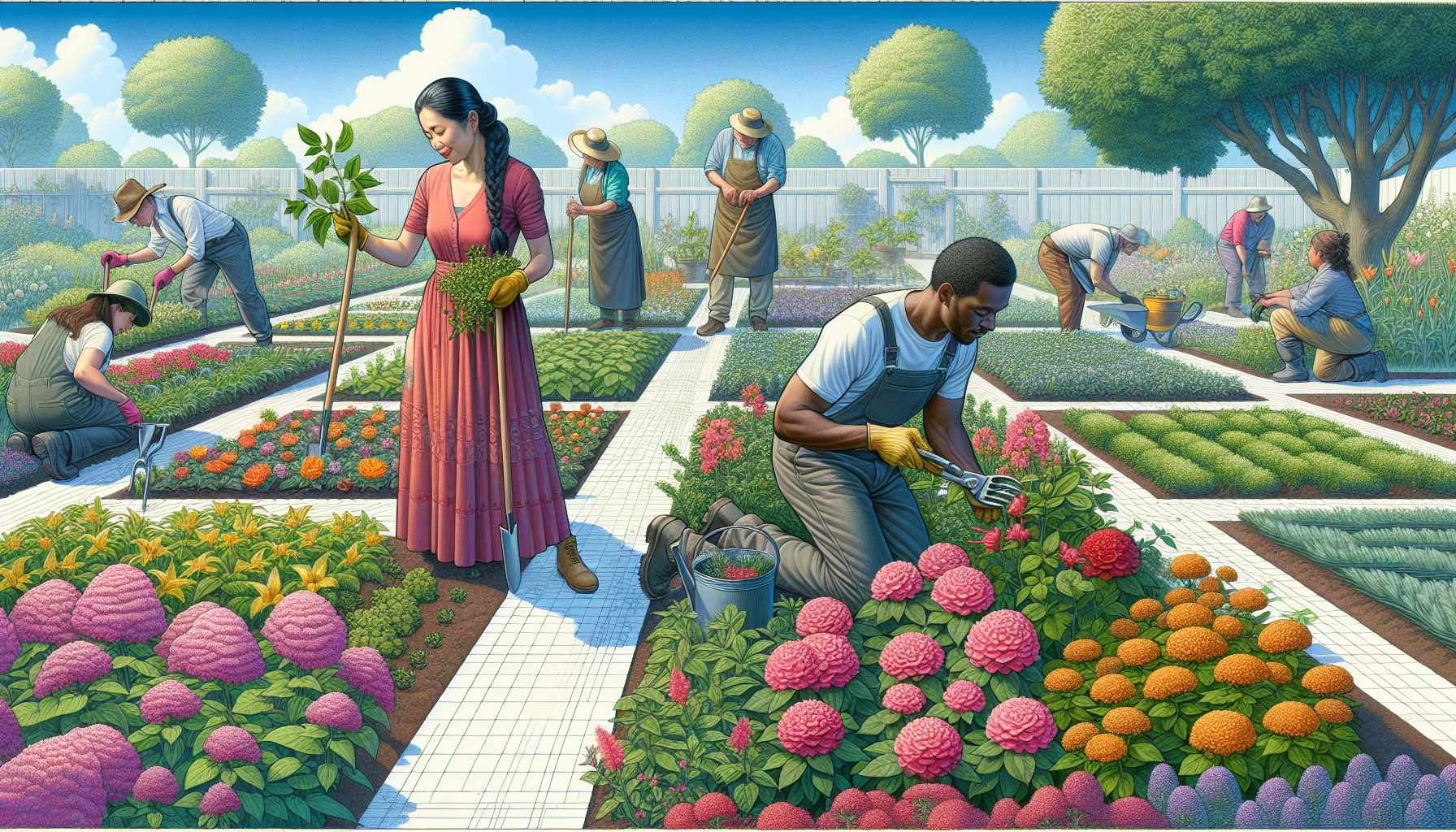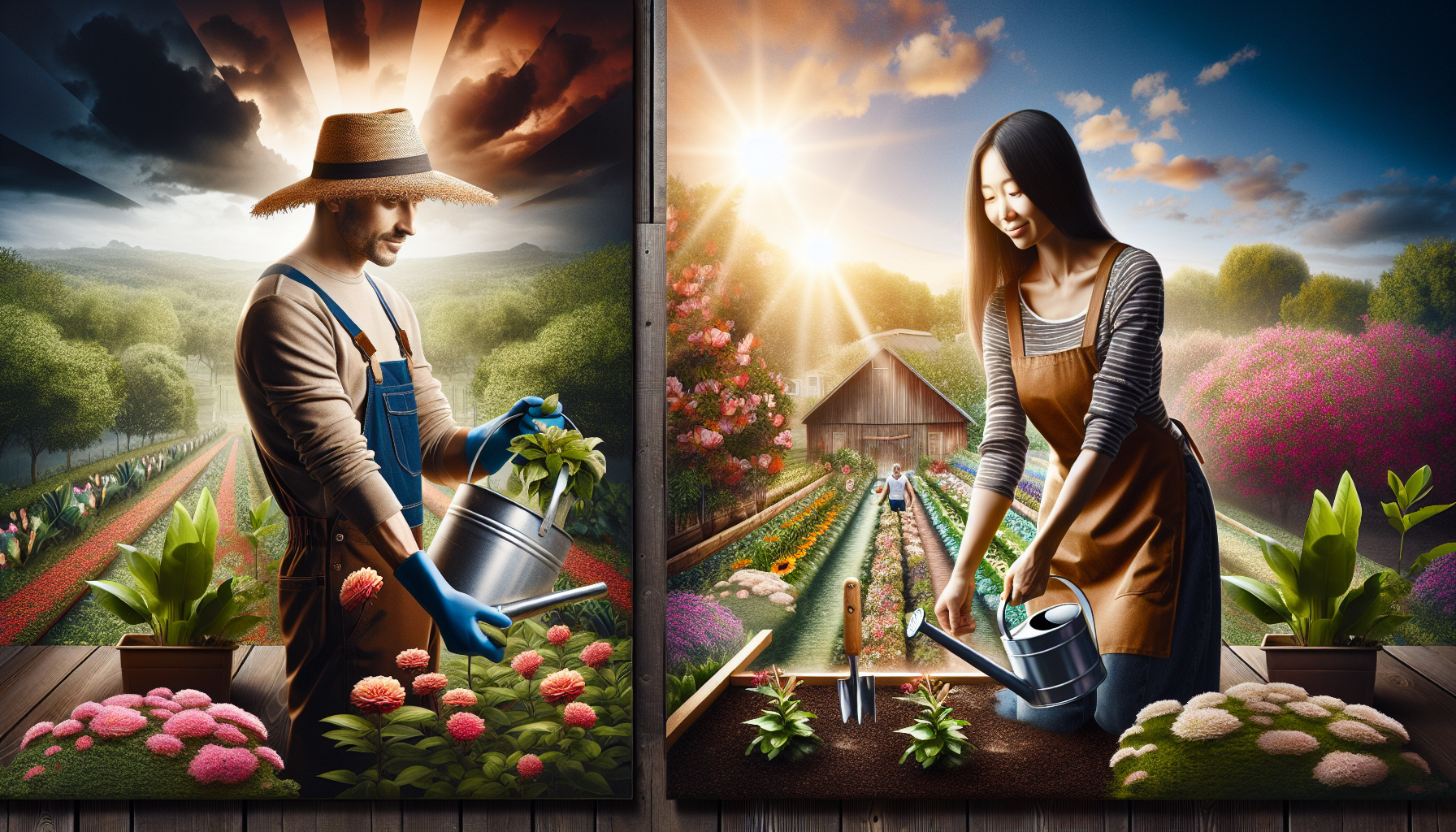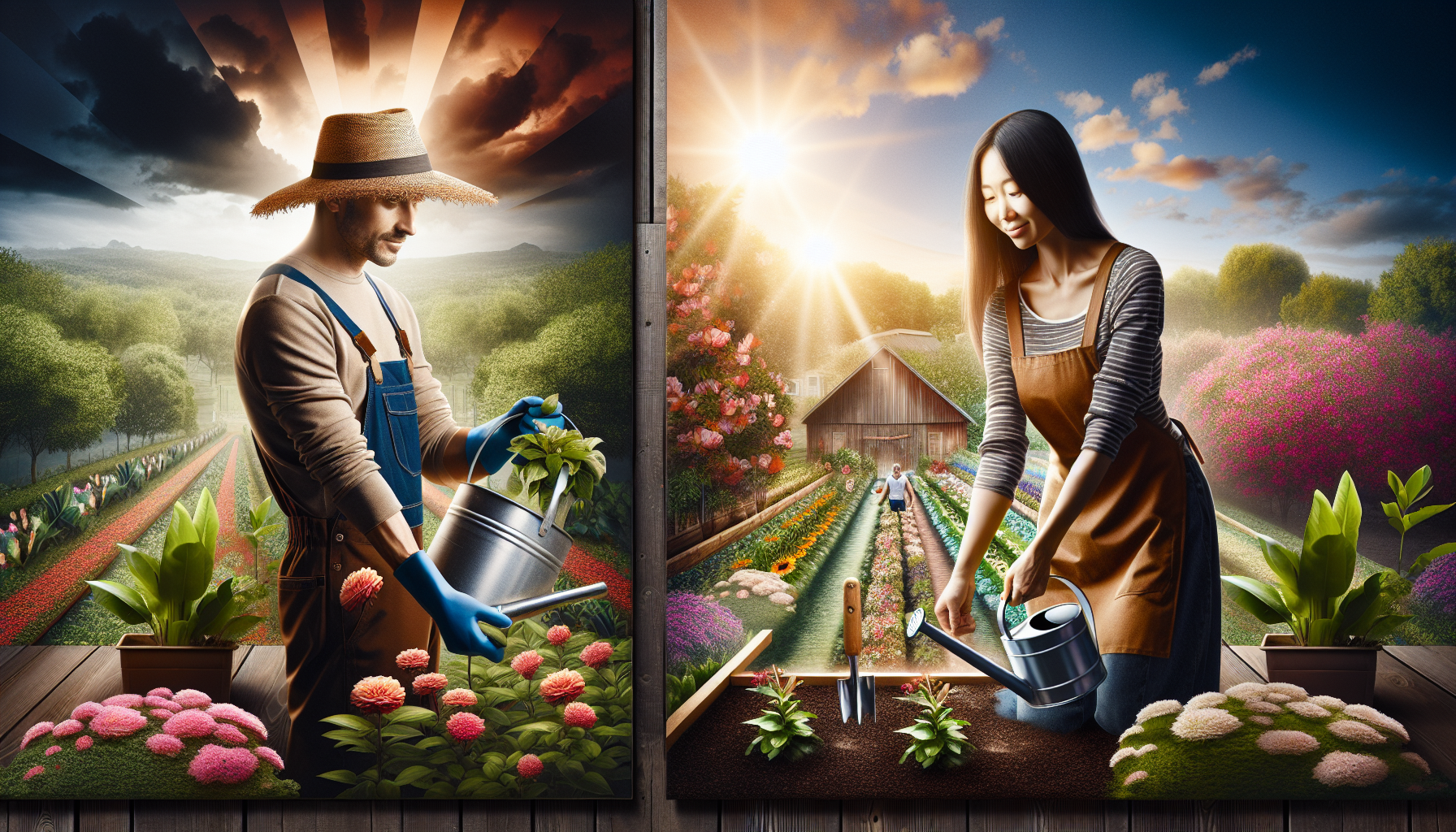Do you ever wonder what exactly gardeners do? Well, they do much more than just tend to flowers and plants. From designing beautiful landscapes to maintaining the overall health and appearance of various outdoor spaces, gardeners play a vital role in creating and maintaining the green spaces we enjoy. They possess a wealth of knowledge about plants, soil, and gardening techniques, allowing them to transform ordinary spaces into breathtaking gardens. So the next time you see a garden that takes your breath away, remember the hard work and expertise that goes into creating such natural wonders. Gardners play a vital role in creating and maintaining beautiful gardens and landscapes. They are knowledgeable in various aspects of gardening, from selecting appropriate plants to designing and implementing changes in existing gardens. Gardners possess the skills and expertise needed to ensure that gardens thrive and flourish. Here is a comprehensive guide on the different tasks and responsibilities involved in the world of gardening.

Planting and Maintaining Gardens
Selecting appropriate plants
When it comes to creating a garden, selecting the right plants is crucial. Gardners consider factors such as climate, soil type, and sunlight exposure to choose plants that will thrive in the specific environment. They have a vast knowledge of various plant species and can recommend the best ones for specific garden designs or desired outcomes.
Preparing the soil
Before planting, gardeners prepare the soil to create an optimal growing environment for plants. This may involve removing weeds, tilling the soil, and adding compost or other organic matter to improve its fertility and structure. By analyzing the soil’s composition and pH levels, gardeners ensure that plants have the best chance of survival and growth.
Planting seeds or seedlings
Once the soil is ready, gardeners plant the seeds or seedlings. They carefully follow instructions regarding the depth, spacing, and timing for each type of plant. Through their expertise, gardeners know how to handle delicate seedlings and ensure they are properly established in their new environment. They work diligently, considering factors such as water requirements and sunlight exposure during the planting process.
Watering and fertilizing
After planting, gardeners maintain a regular watering schedule to keep plants hydrated and healthy. They also provide appropriate fertilization to ensure plants receive the essential nutrients they need for growth and development. Gardeners monitor soil moisture levels and adjust watering accordingly to avoid over or under-watering, as well as apply fertilizers in the correct quantities and at the appropriate times.
Pruning and trimming
Throughout the growth cycle of plants, gardeners perform pruning and trimming tasks to promote healthy growth and maintain desired shapes and sizes. They remove dead or diseased branches, encourage better air circulation, and shape plants for aesthetic purposes. By pruning and trimming, gardeners also help plants direct their energy towards essential areas, leading to healthier overall growth.
Weeding and pest control
To maintain a garden’s health and aesthetics, gardeners regularly remove weeds that compete with desired plants for resources. They employ various techniques, such as hand-weeding or using herbicides, to effectively manage weed growth. Additionally, gardeners monitor and address pest infestations promptly, implementing eco-friendly pest control methods to protect the garden without causing harm to beneficial insects or the environment.
Landscape Design and Installation
Evaluating the site
In landscape design, gardeners begin by evaluating the site to assess its unique features, such as topography, soil quality, and existing vegetation. By thoroughly understanding the site’s characteristics, gardeners can create a design plan that takes advantage of its strengths and overcomes any limitations.
Creating a design plan
Once the site is evaluated, gardeners develop a design plan that incorporates the client’s preferences, budget, and maintenance requirements. They carefully consider factors such as plant selection, hardscape features, pathways, and structures to create a visually appealing and functional garden design. Gardeners have an artistic eye and are skilled in creating harmonious compositions that enhance the natural beauty of the landscape.
Choosing plants and materials
With the design plan in place, gardeners then select appropriate plants and materials to implement the vision. They consider factors such as plant growth habits, seasonal interest, and color schemes to ensure a cohesive and balanced garden. They also source and choose suitable materials for hardscape features like pathways, retaining walls, and outdoor structures, paying attention to durability and aesthetic appeal.
Installing hardscape features
Alongside plantings, gardeners install hardscape features such as patios, walkways, and water features. They possess the necessary skills and tools to construct these elements accurately, paying close attention to details such as proper drainage, stability, and functionality. Gardeners ensure that hardscape features seamlessly integrate with the overall design, enhancing the garden’s overall appearance and usability.
Creating pathways and structures
As part of the landscape installation process, gardeners create pathways and structures that provide practical and aesthetic value. They carefully plan and lay out pathways to encourage smooth movement throughout the garden while complementing the overall design. Additionally, gardeners construct structures such as pergolas, gazebos, or garden sheds to add focal points and create spaces for relaxation or entertaining.

Garden Maintenance
Mowing and lawn care
Garden maintenance involves keeping lawns well-manicured and healthy. Gardners use specialized equipment to mow lawns at the appropriate height, ensuring optimal growth and appearance. They also perform tasks such as aerating, fertilizing, and addressing weed or pest issues to maintain vibrant and lush lawns.
Plant and tree care
To keep plants and trees in optimal condition, gardeners provide regular care, including pruning, fertilization, and pest control. They monitor for signs of disease or nutrient deficiencies and take appropriate actions to address these issues. By providing proper care, gardeners ensure that plants and trees thrive, enhancing the beauty and longevity of the garden.
Seasonal maintenance tasks
Throughout the year, gardeners perform seasonal maintenance tasks to keep gardens looking their best. This may include tasks such as spring clean-ups, fall leaf removal, and winter protection for susceptible plants. Gardeners also adjust watering and fertilization schedules depending on seasonal changes to ensure optimal plant health throughout the year.
Mulching and composting
Mulching and composting are essential practices in garden maintenance. Gardeners apply mulch to suppress weed growth, conserve moisture, and regulate soil temperature. They also create and maintain compost piles to recycle garden and kitchen waste into nutrient-rich organic matter, further enhancing the soil’s fertility and health.
Irrigation system upkeep
Gardeners are responsible for the maintenance and upkeep of irrigation systems. They ensure that irrigation systems are functioning correctly, regularly inspecting components such as pipes, sprinklers, and controllers. Gardeners also adjust watering schedules and make necessary repairs or upgrades to avoid water wastage and ensure efficient water distribution to plants.
Hedge Trimming and Shaping
Trimming to desired shape
Hedge trimming and shaping require precision and skill. Gardeners carefully trim hedges to achieve the desired shape and size while maintaining their health and appearance. By utilizing techniques such as hand trimming or using electric trimmers, they ensure clean lines and uniformity in hedge structures.
Maintaining proper height
Maintaining the proper height of hedges is crucial for their overall health and functionality. Gardeners regularly trim hedges to prevent them from becoming overgrown or encroaching on other areas of the garden. By keeping hedges at an appropriate height, gardeners also ensure privacy, wind protection, and attractive boundaries within the landscape.
Creating intricate designs
For those seeking unique and artistic designs, gardeners can shape hedges into intricate designs. Using specialized tools such as topiary shears, they skillfully craft intricate patterns, shapes, and even sculptures from hedges. This craftsmanship adds a touch of elegance and individuality to any garden or landscape.
Using specialized tools
To achieve the best results in hedge trimming and shaping, gardeners rely on specialized tools. These may include hedge trimmers, shears, pruners, and topiary shears. Gardeners are knowledgeable in the proper use of these tools, ensuring safe and precise trimming while minimizing damage to the plant.

Tree Care
Pruning for health and aesthetics
Tree care involves proper pruning, as it contributes to both tree health and aesthetics. Gardeners assess each tree’s needs, removing dead or diseased branches, promoting better branch structure, and ensuring optimal air circulation. Pruning also helps maintain the tree’s shape and size, enhancing its overall beauty within the landscape.
Tree planting and removal
Gardners are skilled in tree planting, carefully selecting appropriate species and planting them in optimal locations. They consider factors such as soil conditions, drainage, and proximity to structures. In situations where tree removal is necessary, gardeners have the expertise and equipment to safely and efficiently remove trees without causing damage to the surrounding environment.
Diagnosing and treating diseases
Gardeners are trained to diagnose and treat tree diseases. They carefully inspect trees for symptoms of common ailments, such as fungal infections, insect infestations, or nutrient deficiencies. With their knowledge of effective treatment methods, gardeners can help restore tree health and prevent the spread of diseases to other plants in the garden.
Managing insect infestations
Insect infestations can pose a threat to the health and vitality of trees. Gardeners are knowledgeable in identifying different types of pests and implementing effective control measures. They may employ methods such as organic pest control or integrated pest management to address infestations while minimizing harm to beneficial insects and the environment.
Stump grinding and removal
When trees are removed, gardeners provide stump grinding and removal services. They use specialized equipment to grind down tree stumps, removing them below ground level. This allows for proper re-landscaping or construction in the area, ensuring a safe and visually appealing garden environment.
Garden Renovation
Assessing the existing garden
Garden renovation starts with a careful assessment of the existing garden’s strengths, weaknesses, and desired changes. Gardeners evaluate plant health, soil conditions, drainage issues, and design elements to determine the most effective renovation plan.
Removing unwanted plants or structures
As part of the renovation process, gardeners remove unwanted plants or structures. They meticulously remove plants or structures that are no longer desirable, ensuring minimal disruption to the rest of the garden. By clearing space, gardeners make way for new features and plants that will enhance the garden’s overall appeal.
Designing and implementing changes
Based on the assessment and client preferences, gardeners design and implement changes in the existing garden. This may involve restructuring pathways, creating new planting beds, or introducing new focal points. Through their expertise, gardeners create visually pleasing and functional garden spaces that align with clients’ vision and desired outcomes.
Adding new features and plants
Gardeners have access to a vast selection of plants and materials, making them the ideal professionals to add new features and plants during a garden renovation. They carefully choose appropriate plants that complement the garden’s design and are well-suited to the environmental conditions. Gardeners also install new features such as water features, seating areas, or outdoor structures to enhance the garden’s aesthetics and functionality.
Plant Propagation
Collecting and storing seeds
Plant propagation involves collecting and storing seeds. Gardeners carefully collect seeds from healthy and desirable plants, ensuring they are fully mature and viable. They then store the seeds properly to maintain their quality and viability until they are ready to be sown.
Taking plant cuttings
Another method of propagation is taking plant cuttings. Gardeners skillfully select and cut sections from plants, usually from stems or branches, and encourage them to develop roots. They provide the optimal conditions for these cuttings to root, establishing new plants that closely resemble the parent plant.
Dividing plants
Gardeners can also propagate plants through division. This technique involves carefully separating established plants into smaller sections, each with its own root system. These divided sections can then be replanted, resulting in multiple new plants.
Creating new hybrids
For those interested in creating unique plant varieties, gardeners can engage in hybridization. This process involves crossbreeding plants with desirable traits to create new hybrids. Gardeners carefully select parent plants and employ specialized techniques to achieve successful hybridization, resulting in plants with desired characteristics.
Nurturing young plants
Once new plants have been propagated, gardeners nurture them through their early stages of growth. They provide appropriate care, including watering, fertilization, and protection from pests and diseases. Through their diligent attention, gardeners ensure the healthy development of young plants and their successful integration into the garden.
Greenhouse Management
Maintaining optimal temperature and humidity
In greenhouse management, gardeners maintain optimal temperature and humidity levels to provide ideal growing conditions for plants. They monitor and adjust climate control systems, ensuring plants receive the right balance of warmth and humidity for their specific needs.
Managing ventilation and lighting
Gardeners also manage greenhouse ventilation and lighting. They regulate airflow to prevent excessive heat or humidity buildup, as well as ensure adequate air circulation for proper plant growth. Additionally, gardeners optimize lighting conditions, using artificial light sources when necessary, to support plant development in the absence of natural sunlight.
Watering and fertilizing plants
Greenhouse plants require regular watering and fertilization. Gardeners develop watering schedules suitable for each plant type and adjust them as needed to prevent waterlogging or dehydration. They also administer appropriate fertilizers to supply essential nutrients for healthy growth, closely monitoring plant responses to ensure optimal uptake.
Controlling pests and diseases
As in any garden setting, greenhouse plants may be susceptible to pests and diseases. Gardeners implement proactive pest and disease management strategies by regularly inspecting plants, utilizing natural predators or organic controls, and promptly addressing any signs of infestation or infection. Through diligent monitoring and treatment, gardeners maintain a healthy and thriving greenhouse environment.
Propagating and transplanting seedlings
Greenhouses serve as ideal environments for propagating and transplanting seedlings. Gardeners sow seeds, promote germination, and nurture delicate seedlings until they are ready to be transplanted. They carefully transplant young plants into larger containers or outdoor garden beds, ensuring minimal stress and optimal conditions for continued growth.
Garden Consultation and Advice
Site visit and evaluation
Gardners offer garden consultation services beginning with a site visit to evaluate specific needs and goals. They assess the existing garden, considering factors such as soil conditions, lighting, and available space. Through their expertise, gardeners gain a holistic understanding of the garden’s potential and limitations.
Identifying specific needs and goals
During the consultation process, gardeners engage in conversations with clients to identify their specific needs and goals for their garden. They explore design preferences, desired plant varieties, and maintenance requirements. By understanding clients’ desires and expectations, gardeners can provide tailored recommendations and solutions.
Offering expert recommendations
Drawing upon their extensive knowledge and experience, gardeners provide expert recommendations to clients. They suggest suitable plant species, design ideas, and maintenance practices that align with clients’ goals and budget. Whether it is selecting drought-tolerant plants or designing a low-maintenance garden, gardeners offer valuable insights to help clients achieve their desired garden outcomes.
Providing ongoing support and guidance
Gardeners offer ongoing support and guidance to clients even after the initial consultation. They are available to answer questions, provide troubleshooting advice, and offer recommendations throughout the gardening journey. With their assistance, gardeners empower clients to confidently nurture and maintain their gardens while ensuring long-term success and satisfaction.
Outdoor Lighting Design
Assessing lighting needs and objectives
Outdoor lighting design involves assessing lighting needs and objectives. Gardeners evaluate the specific areas in the garden that require lighting to enhance safety, highlight key features, or create ambiance. They consider factors such as pathway lighting, accent lighting for focal points, and overall illumination requirements.
Selecting suitable fixtures and bulbs
Gardeners guide clients in selecting suitable fixtures and bulbs for outdoor lighting installations. They consider factors such as durability, energy efficiency, and the desired lighting effect. Gardeners also ensure that fixtures and bulbs are compatible with the garden’s design style, harmonizing with the overall aesthetics.
Installing wiring and fixtures
Proficient in electrical work, gardeners install the necessary wiring and fixtures for outdoor lighting systems. They carefully plan and execute wiring layouts, ensuring proper connections and adherence to safety regulations. Gardeners install fixtures securely, taking into account the garden’s layout and long-term maintenance requirements.
Creating ambiance and highlighting key features
Outdoor lighting design aims to create ambiance and highlight key features within the garden. Gardeners strategically position lights to enhance the garden’s nighttime appeal and draw attention to specific focal points, such as statues, water features, or architectural elements. Through skilled lighting placement, gardeners transform the garden into a captivating and inviting space after the sun sets.
Gardners play a vital role in the creation and maintenance of gardens, offering a wide range of services that ensure the health, beauty, and functionality of garden spaces. Whether it’s selecting appropriate plants, designing landscapes, or providing ongoing care and advice, gardeners are dedicated professionals who bring expertise and passion to every aspect of gardening. With their assistance, you can transform your outdoor space into a stunning and thriving garden that brings joy and tranquility for years to come.
